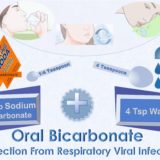Reverse Diabetes And The Metabolic Syndrome | Free Trial In Texas

The Metabolic Syndrome includes Abdominal Obesity, High Levels of Blood Sugar, High Blood Pressure, Atherogenic Fat Metabolism and Low HDL Cholesterol. Having three or more of these together defines The Metabolic Syndrome and greatly increases the risk of Type 2 Diabetes, Heart Disease, Stroke and All-Cause Mortality.
All features of The Metabolic Syndrome are the result of excess calories causing high levels of insulin. More sugar and fat than intramuscular glycogen and fat can store causes the pancreas to secrete more and more insulin.
Medications for diabetes that lower blood sugar levels by replacing, imitating or enhancing insulin often leave insulin levels dangerously high.
It’s decreasing body fat and increasing muscle mass that lowers insulin, improves long-term health and restores life expectancy.
To learn more about the programs Herd Healthcare offers, our website is:
www.herdhealthcare.com
Cause Of Metabolic Syndrome
Excess Calorie Intake
Sugar, fat and protein absorbed from the gut are cleared into tissues all over the body. Most of the protein is cleared into the liver. Some tissues like skeletal muscle require very little insulin to quickly absorb a lot of sugar and fat when active or recovering from mechanical work. Most other tissues absorb sugar and fat much less quickly and require much more insulin.
Resting muscle continues to absorb sugar and fat until storage in glycogen and fat depots is complete. When fully recovered from exercise it stops absorbing sugar and fat. At that point, sugar and fat become excess calories and insulin levels stay high until amounts fall to resting levels.
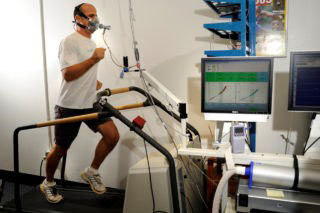 Limits for usable levels of sugar and fat are set by requirements for energy by all tissues at rest plus amounts to replenish stores in active skeletal muscle.
Limits for usable levels of sugar and fat are set by requirements for energy by all tissues at rest plus amounts to replenish stores in active skeletal muscle.
Lots of muscle and lots of physical work create storage space for lots of sugar and fat. Individuals with little muscle and little physical activity frequently consume excess levels of energy that must be stored in fat tissue and other organs all over the body. That requires sustained high levels of insulin in the circulation.
Adipogenicity
Excess calories are stored in fat tissue. The cells in fat tissue are called adipocytes and creating new cells in fat tissue is called adipogenicity.
Creating fat cells and storing sugar and fat tissue is influenced heavily by levels of insulin in the blood. How that influence is expressed depends on genetics and repeated exposure of fat cells to high levels of insulin, sugar and fat.
Maximum Waist Circumference
The measurement of inches around the waist at the level of the umbilicus includes internal fat deposits which coat organs deep in the abdominal cavity. It increases and decreases in relation to changes in fat tissue stores all over the body. In general, a change of 1 inch waist circumference reflects a change of 7 to 10 pounds in total body weight.
This measurement should be not greater than 40 inches in a man nor greater than 35 inches in a woman.
Early Indicators of Metabolic Syndrome
Development of the Metabolic Syndrome begins with higher than normal levels of insulin before eating in the morning. A study of fasting insulin levels was done with 1,968 men and women in San Antonio. Subjects who did not have any signs of Metabolic Syndrome at their first examination were examined again 8 years later.
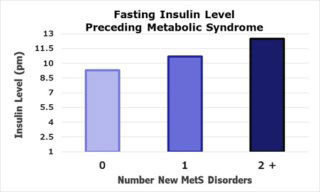 As shown in the Figure, those who later developed signs of Metabolic Syndrome had higher fasting levels of insulin than those who did not. The greater the level of insulin at baseline, the greater was the number of signs 8 years later. Also, those with the most Waist Circumference at baseline had the most signs of Metabolic Syndrome 8 years later.
As shown in the Figure, those who later developed signs of Metabolic Syndrome had higher fasting levels of insulin than those who did not. The greater the level of insulin at baseline, the greater was the number of signs 8 years later. Also, those with the most Waist Circumference at baseline had the most signs of Metabolic Syndrome 8 years later.
Both maximum Waist Circumference and Fasting Insulin levels were reliable predictors for development of the Metabolic Syndrome.
Insulin Resistance
Maximum facilitation of skeletal muscle cells to absorb sugar and fat results in rapid clearance from the circulation. Eventually resting skeletal muscle is filled to capacity with sugar and fat stored in glycogen and complex fat molecules. At that point, further removal of sugar and fat into other tissues becomes much slower and requires higher levels of insulin.
The level of insulin required to remove high levels of sugar and fat from the blood is a measure of Insulin Resistance.
The scale of Insulin Resistance is controlled by the metabolic requirements of skeletal muscle for sugar and fat to supply the energy for mechanical work and restoration of stored supplies of energy for immediate use.
Consequences of Hyperinsulinemia
Hypertension
Insulin level in blood affects cells in the brain as well as the rest of the body. Levels of insulin reaching brain cells influences the control of Sympathetic Nervous System including constriction of small arteries throughout the whole body.
High levels of insulin also influence the kidneys to reabsorb sodium, expand blood volume and support high blood pressure.
Microvascular Disease
Insulin stimulates disorganized proliferation of small blood vessels throughout the body causing:
•proliferative retinitis
•neuropathy
•renal failure
•peripheral arterial disease
Atherogenic Dyslipidemia
The combination of hyperglycemia and high levels of insulin combine with inherited characteristics to cause fatty plaque formation in major arteries.
Thrombosis and Fibrinolysis
High levels of insulin circulating through arteries and veins cause formation and persistence of clots in blood vessels throughout the body.
Dementia and Mental Health
Type 2 Diabetes, Hypertension and Clot Formation promote Dementia including Alzheimer’s Disease. Also, Diabetes is a strong risk factor for Depression.
CVD and All-Cause Morbidity and Mortality
The likelihood of developing Metabolic Syndrome increases with severity of Overweight/Obesity. About 5% of men who have healthy weight develop Metabolic Syndrome. However, 20% of men who are Overweight and 62% of men who are Obese develop Metabolic Syndrome. The risk for mortality from all causes also increases with Overweight/Obesity.
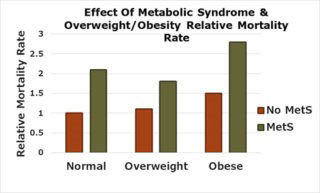 Metabolic Syndrome and Morality Rates were studied for 9,173 men in Texas. As shown in the Figure, those with the Metabolic Syndrome who were Normal in weight or Overweight had about double the Mortality Rate compared to men without Metabolic Syndrome. Men who did not have Metabolic Syndrome but were Obese had a 50% increase in Mortality Rate. Those who were Obese and had signs of the Metabolic Syndrome had almost 3 times the Mortality rate of men who were completely healthy.
Metabolic Syndrome and Morality Rates were studied for 9,173 men in Texas. As shown in the Figure, those with the Metabolic Syndrome who were Normal in weight or Overweight had about double the Mortality Rate compared to men without Metabolic Syndrome. Men who did not have Metabolic Syndrome but were Obese had a 50% increase in Mortality Rate. Those who were Obese and had signs of the Metabolic Syndrome had almost 3 times the Mortality rate of men who were completely healthy.
Cardio-Respiratory Fitness (CRF)
Many clinical studies of physical activity have demonstrated that exercise prevents or controls the Metabolic Syndrome. The effect of exercise on signs of the Metabolic Syndrome is separate from effects of reducing weight. Only high intensity exercise is associated with weight reduction while levels of insulin are reduced by only mild changes in physical fitness without change in body weight.
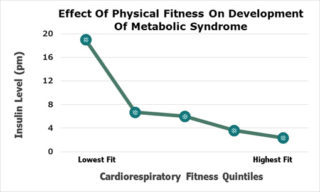 The Figure shows that signs of the Metabolic Syndrome develop in almost 20% of otherwise healthy men and women who are completely sedentary. In contrast, only 2% among the top quintile of men and women who are well conditioned develop the Metabolic Syndrome.
The Figure shows that signs of the Metabolic Syndrome develop in almost 20% of otherwise healthy men and women who are completely sedentary. In contrast, only 2% among the top quintile of men and women who are well conditioned develop the Metabolic Syndrome.
The benefits of physical fitness for mortality outcomes is demonstrated for 19,000 men in Texas. The Figure shows that risk for all-cause mortality in men with signs of Metabolic Syndrome was 1.3 compared to those completely healthy. The risk for death from cardiovascular disease in men with signs of Metabolic Syndrome was 1.8. In contrast, the risk for all-cause mortality in men with Metabolic Syndrome who were physically fit were slightly less than completely healthy men who were less physically fit.
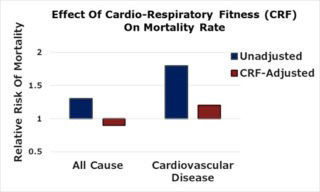 Results were even more obvious in mortality outcomes for men with cardiovascular disease. The overall mortality risk for men with cardiovascular disease who were physically fit was 1.2 compared to 1.8 in those who were physically unfit.
Results were even more obvious in mortality outcomes for men with cardiovascular disease. The overall mortality risk for men with cardiovascular disease who were physically fit was 1.2 compared to 1.8 in those who were physically unfit.
These results show that Cardio-Respiratory Fitness protects men equally with signs of Metabolic Syndrome in men who are physically unfit.
Quality Of Sleep
Good sleep duration greatly reduces risk of poor health and premature death. A population of 1,344 men and women in Pennsylvania were studied in a sleep lab and followed for 17 years. Approximately 40% met criteria defining Metabolic Syndrome. During the sleep study, approximately 50% slept more than 6 hours and 50% slept less. Approximately 20% died during the follow-up and approximately half of the deaths were due to cardiovascular (CVD) or cerebrovascular (CBV) causes.
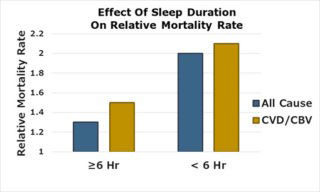 As shown in the Figure, those who slept fewer than 6 hours had more than twice the rate of death compared to those who slept at least 6 hours. Death rates were almost the same for all causes as for those due to cardiovascular and cerebrovascular causes.
As shown in the Figure, those who slept fewer than 6 hours had more than twice the rate of death compared to those who slept at least 6 hours. Death rates were almost the same for all causes as for those due to cardiovascular and cerebrovascular causes.
Almost all the differences in mortality rates among those with Metabolic Syndrome were due to high blood pressure or type 2 diabetes.
Consequences Of The Metabolic Syndrome
Gaining weight does more damage to your health and length of life than getting older. When weight increases, levels of insulin rise and damage organ systems more than loss of organ function caused by aging.
Controlling blood glucose, blood pressure and blood lipids is important but nothing is more important than controlling levels of insulin.
When fasting insulin levels are normal, other threats to health and life are much more readily controlled.
Success in Reversing Diabetes and The Metabolic Syndrome comes with reducing maxWaist/Height Ratio to less than 0.5.
 We are pleased to share our blog articles with you, and we are always interested to hear from our readers. Our website address is: www.herdhealthcare.com
We are pleased to share our blog articles with you, and we are always interested to hear from our readers. Our website address is: www.herdhealthcare.com




